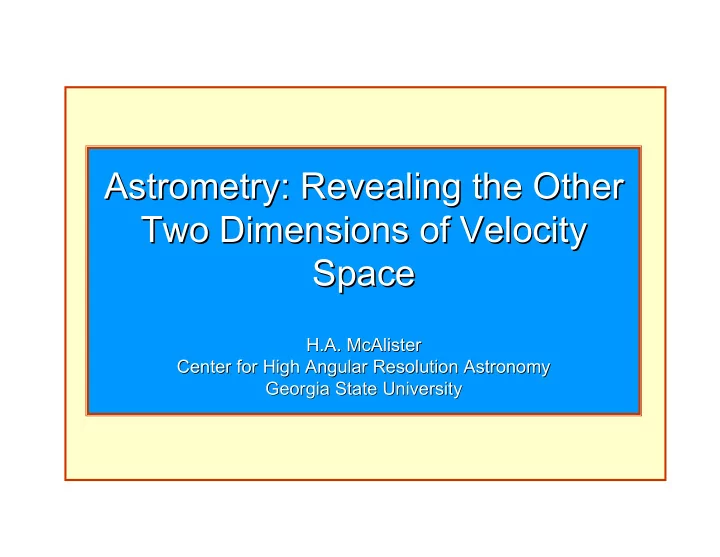

Astrometry: Revealing the Other Astrometry: Revealing the Other Two Dimensions of Velocity Two Dimensions of Velocity Space Space H.A. McAlister H.A. McAlister Center for High Angular Resolution Astronomy Center for High Angular Resolution Astronomy Georgia State University Georgia State University
Astrometry: What is It? • Astrometry deals with the measurement of the positions and motions of astronomical objects on the celestial sphere. Two main subfields are: • Spherical Astrometry – Determines an inertial reference frame, traditionally using meridian circles, within which stellar proper motions and parallaxes can be measured. Also known as fundamental or global astrometry. • Plane Astrometry – Operates over a restricted field of view, using, through much of the 20 th century, long-focus refractors at plate scales of 15 to 20 arcsec/mm, with the goal of accurately measuring stellar parallax. Also known as long-focus or small-angle astrometry. • Astrometry relies on specialized instrumentation and observational and analysis techniques. It is fundamental to all other fields of astronomy.
Astrometry: What are its tools? • Spherical Astrometry: • Meridian circles & transits • Astrolabes • Space (eg. Hipparcos) • Phased optical interferometry • Very long baseline radio interferometry • Plane Astrometry: • Photography (until relatively recently) • Visual Micrometry (until relatively recently) • CCD imaging • Scanning photometry • Speckle interferometry (O/IR) • Michelson interferometry (O/IR) • Radio interferometry • Space (imaging & interferometry)
Some 19 th & 20 th C. Astrometric Instruments Greenwich Meridian Circle House USNO 6-in Transit Circle 1898-1995 Photo from National Maritime Museum, Greenwich U.S. Naval Observatory Photo W. Finsen’s Eyepiece Hipparcos Test 1988 Interferometer c. 1960 Worley’s recording filar micrometer at USNO ESA Photo U.S. Naval Observatory Photo
Spherical Astrometry What does it measure? Spherical Astrometry attempts to measure stellar & planetary positions and motions in an inertial reference frame. This is very challenging and must account for effects of: • Proper motion • Aberration • Parallax • Polar wandering • Galactic rotation • Refraction • Precession • Solar motion • Nutation • Earth dynamics (including time) Oh, yeah, and whatever the heck systematics are in your instrumental and reduction methodology! A truly inertial reference frame has been achieved through the tie-in to extragalactic radio sources using VLBI. Sound difficult? It is!
Plane Astrometry What does it measure? Plane Astrometry attempts to measure small angle effects relative to a background of one or more reference stars. These effects include: • Proper motion • Parallax (relative and absolute) • Secular acceleration • Sub-motions arising from unseen companions • Binary star relative separation and orientation • Stellar diameters And, here again, whatever the heck systematics are in your instrumental and reduction methodology! Also sound difficult? It is!
Astrometry What does it give us? Spherical Astrometry gives us: • Galactic kinematics and dynamics • Solar system dynamics • Time • Periodic and secular changes in Earth orientation • Navigation (mostly historical except during WWIII) Plane Astrometry gives us, when combined with other techniques, stellar: • Space velocities • Luminosities • Distribution in solar • Masses neighborhood • Diameters (and shapes) • Unseen companions • Temperatures • Calibration of cosmic • Multiplicity frequencies distance scale And, yet again, the systematics in your instrumental and reduction methodology must be understood! Sound useful? It sure is! “Astrometry is the metrological basis of astronomy” from J. Kovalevsky, Modern Astrometry, p.8.
Astrometry for Dummies This says it all (Circulated c. 1974 by Ron Probst at UVa)
Okay, here’s a basic: Trigonometric Parallax A star is observed against a background of distant stars at 6-month intervals t 1 Trig Parallax = � � Earth’s orbit Nearby Star t 2 Very Distant 2 x � Background Stars t 2 t 1 The nearby star appears to shift back and forth with respect to the background stars
Okay, here’s a basic: Trigonometric Parallax A star is observed against a background of distant stars at 6-month intervals t 1 Trig Parallax = � � Earth’s orbit More Distant Star t 2 Very Distant 2 x � Background Stars t 2 t 1 A somewhat more distant star presents a smaller back and forth motion with respect to the background stars
The Challenge of Astrometry • Astrometry constantly pushes the limits imposed by the current status of its instrumentation and reduction & analysis techniques. • Historically, breakthroughs in astrometry are almost always the result of discrete advances in instrumentation followed by refinements made by clever people. • Ultimately, astrometry is all about understanding and probing the distinction between precision and accuracy.
Gain in Accuracy Adapted from Parallax by A. W. Hirshfield Observer Technique Date Limiting Gain Accuracy Hipparchus visual sextant 150 BC 5 arcmin 1 Tycho visual quadrant 1600 1 arcmin 5 Telescope Flamsteed mural quadrant 1700 10 arcsec 30 Bradley improved quadrant 1750 0.5 arcsec 600 3 x 10 3 Bessel visual heliometer 1835 0.1 arcsec Photography Schlesinger et al. early photography 1920 0.05 arcsec 6 x 10 3 USNO et al. later photography 1970 5 mas 6 x 10 4 Various speckle interferometry 1990 3 mas 1 x 10 5 USNO et al. CCD imagine 2000 1 mas 3 x 10 5 HIPPARCOS space craft 1990 1 mas 3 x 10 5 HST FGS 2000 0.5 mas 6 x 10 5 Various long-baseline interfer. 2000 100 µas 3 x 10 6 3 x 10 7 GAIA (ESA) space craft 2010 10 µas OBSS (USNO/NASA) space craft ? 10 µas 3 x 10 7 SIM (JPL/NASA) space interferometry 2009 1 µas 3 x 10 8
Recommend
More recommend